
Concept explainers
(a)
Interpretation:
The isomeric structures of octane having five carbons in their principal chains are to be drawn. The naming for all the structures is to be stated.
Concept introduction:
The naming of the chemical compound is done using the parameters given by IUPAC. IUPAC stands for International Union of Pure and Applied Chemistry. This system of nomenclature is accepted worldwide. The IUPAC system provides the set of rules in order to do the naming of the chemical compounds.
Isomers are the chemical compounds which have same chemical formula but different arrangement of molecules.
Answer to Problem 2.26AP
The isomeric structures of octane having five carbons in their principal chains along with their names are drawn below as,
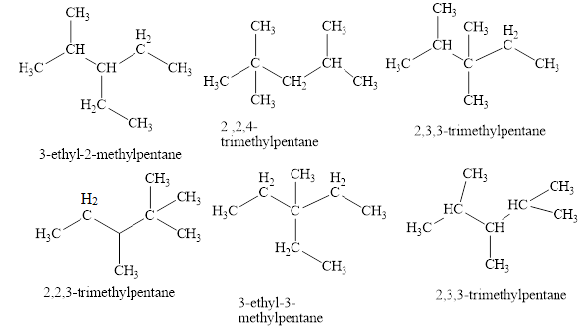
Explanation of Solution
The structure of octane can be drawn as shown in figure 1.
![]()
Figure 1
The isomers of the octane having five carbons in their principal chains can be drawn by rearranging the carbon atoms.
The first isomer is shown in figure 2 as,
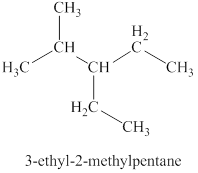
Figure 2
For the naming of the compound, the longest carbon chain is selected first. In the given compound the longest carbon chain has
The second isomer is shown in figure 3 as,
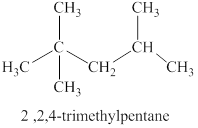
Figure 3
For the naming of the compound the longest carbon chain is selected first. In the given compound the longest carbon chain has
The third isomer is shown in figure 4 as,
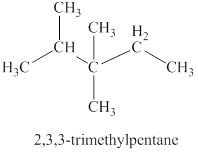
Figure 4
For the naming of the compound the longest carbon chain is selected first. In the given compound the longest carbon chain has
The fourth isomer is shown in figure 5 as,
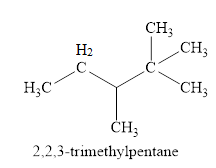
Figure 5
For the naming of the compound the longest carbon chain is selected first. In the given compound the longest carbon chain has
The fifth isomer is shown in figure 6 as,
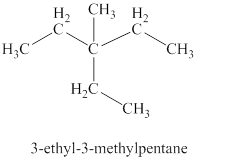
Figure 6
For the naming of the compound the longest carbon chain is selected first. In the given compound the longest carbon chain has
The sixth isomer is shown in figure 7 as,
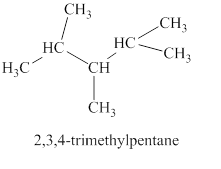
Figure 7
For the naming of the compound the longest carbon chain is selected first. In the given compound the longest carbon chain has
The isomeric structures of octane having five carbons in their principal chains along with their names are shown in figure 2 to 7.
(b)
Interpretation:
The isomeric structures of octane having six carbons in their principal chains are to be drawn. The naming for all the structures is to be stated.
Concept introduction:
The naming of the chemical compound is done using the parameters given by IUPAC. IUPAC stands for International Union of Pure and Applied Chemistry. This system of nomenclature is accepted worldwide. The IUPAC system provides the set of rules in order to do the naming of the chemical compounds.
Isomers are the chemical compounds which have same chemical formula but different arrangement of molecules.
Answer to Problem 2.26AP
The isomeric structures of octane having six carbons in their principal chains along with their names are drawn below as,
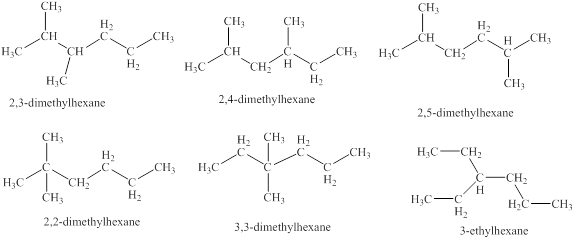
Explanation of Solution
The isomers of the octane having six carbons in their principal chains can be drawn by rearranging the carbon atoms.
The first isomer is shown in figure 8 as,
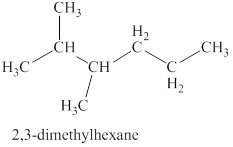
Figure 8
For the naming of the compound the longest carbon chain is selected first. In the given compound the longest carbon chain has
The second isomer is shown in figure 9 as,
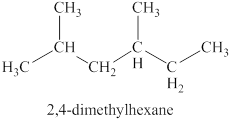
Figure 9
For the naming of the compound the longest carbon chain is selected first. In the given compound the longest carbon chain has
The third isomer is shown in figure 10 as,
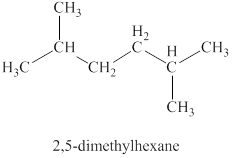
Figure 10
For the naming of the compound the longest carbon chain is selected first. In the given compound the longest carbon chain has
The fourth isomer is shown in figure 11 as,
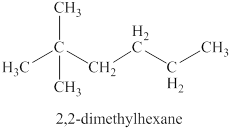
Figure 11
For the naming of the compound the longest carbon chain is selected first. In the given compound the longest carbon chain has
The fifth isomer is shown in figure 12 as,
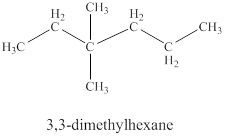
Figure 12
For the naming of the compound the longest carbon chain is selected first. In the given compound the longest carbon chain has
The sixth isomer is shown in figure 13 as,
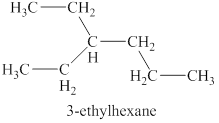
Figure 13
For the naming of the compound the longest carbon chain is selected first. In the given compound the longest chain carbon has
The isomeric structures of octane having six carbons in their principal chains along with their names are shown in figure 8 to 13.
Want to see more full solutions like this?
Chapter 2 Solutions
Organic Chemistry Study Guide and Solutions
- An open vessel containing water stands in a laboratory measuring 5.0 m x 5.0 m x 3.0 m at 25 °C ; the vapor pressure (vp) of water at this temperature is 3.2 kPa. When the system has come to equilibrium, what mass of water will be found in the air if there is no ventilation? Repeat the calculation for open vessels containing benzene (vp = 13.1 kPa) and mercury (vp = 0.23 Pa)arrow_forwardEvery chemist knows to ‘add acid to water with constant stirring’ when diluting a concentrated acid in order to keep the solution from spewing boiling acid all over the place. Explain how this one fact is enough to prove that strong acids and water do not form ideal solutions.arrow_forwardThe predominant components of our atmosphere are N₂, O₂, and Ar in the following mole fractions: χN2 = 0.780, χO2 = 0.21, χAr = 0.01. Assuming that these molecules act as ideal gases, calculate ΔGmix, ΔSmix, and ΔHmix when the total pressure is 1 bar and the temperature is 300 K.arrow_forward
- dG = Vdp - SdT + μA dnA + μB dnB + ... so that under constant pressure and temperature conditions, the chemical potential of a component is the rate of change of the Gibbs energy of the system with respect to changing composition, μJ = (∂G / ∂nJ)p,T,n' Using first principles prove that under conditions of constant volume and temperature, the chemical potential is a measure of the partial molar Helmholtz energy (μJ = (∂A / ∂nJ)V,T,n')arrow_forwardThe vapor pressure of dichloromethane at 20.0 °C is 58.0 kPa and its enthalpy of vaporization is 32.7 kJ/mol. Estimate the temperature at which its vapor pressure is 66.0 kPa.arrow_forwardDraw the structure of A, the minor E1 product of the reaction. Cl Skip Part Check F1 esc CH_CH OH, D 3 2 Click and drag to start drawing a structure. 80 R3 F4 F2 F3 @ 2 # $ 4 3 Q W 95 % KO 5 F6 A F7 × G ☐ Save For Later Sub 2025 McGraw Hill LLC. All Rights Reserved. Terms of Use | Privacy C ►II A A F8 F9 F10 FL 6 7 88 & * 8 9 LLI E R T Y U A S D lock LL F G H 0 P J K L Z X C V B N M 9 Harrow_forward
- From the choices given, which two substances have the same crystal structure? (Select both) Group of answer choices ZnS (zincblende) Diamond TiO2 (rutile) ZnS (wurtzite)arrow_forwardPotassium (K) blends with germanium (Ge) to form a Zintl phase with a chemical formula of K4Ge4. Which of the following elements would you expect potassium to blend with to form an alloy? Electronegativities: As (2.0), Cl (3.0), Ge (1.8), K (0.8), S (2.5), Ti (1.5) Group of answer choices Arsenic (As) Sulfur (S) Chlorine (Cl) Titanium (Ti)arrow_forwardConsider two elements, X and Z. Both have cubic-based unit cells with the same edge lengths. X has a bcc unit cell while Z has a fcc unit cell. Which of the following statements is TRUE? Group of answer choices Z has a larger density than X X has more particles in its unit cell than Z does X has a larger density than Z Z has a larger unit cell volume than Xarrow_forward
- How many particles does a face-centered cubic (fcc) unit cell contain? Group of answer choices 2 14 8 4arrow_forwardV Highlight all of the carbon atoms that have at least one beta (B) hydrogen, using red for one ẞ hydrogen, blue for two ẞ hydrogens, and green for three ẞ hydrogens. If none of the carbon atoms have ẞ hydrogens, check the box underneath the molecule. ED X None of the carbon atoms have ẞ hydrogens. Explanation esc 2 Check * F1 F2 1 2 80 # 3 Q W tab A caps lock shift fn control F3 N S option O 694 $ F4 F5 F6 005 % E R D F LL 6 olo 18 Ar B © 2025 McGraw Hill LLC. All Rights Reserved. Terms of Use | Privacy Center | Accessibility A DII F7 F8 87 & * 8 T Y U G H 4 F9 F10 ( 9 0 E F11 F12 உ J K L + || X C V B N M H H command option commandarrow_forwardConsider the reaction below and answer the following questions. Part 1 of 4 Br NaOCH2CH3 Identify the mechanisms involved. Check all that apply. SN 1 SN 2 E1 E2 None of the above Part 2 of 4 Skip Part Check esc F1 F2 lock 1 2 Q W A S #3 80 F3 F4 F5 F6 Save For © 2025 McGraw Hill LLC. All Rights Reserved. Terms ˇˇ % & 4 5 6 89 7 IK A 分 བ F7 F8 F9 F * E R T Y U 8 9 D F G H K V B N M 0 Oarrow_forward
 Introductory Chemistry: An Active Learning Approa...ChemistryISBN:9781305079250Author:Mark S. Cracolice, Ed PetersPublisher:Cengage Learning
Introductory Chemistry: An Active Learning Approa...ChemistryISBN:9781305079250Author:Mark S. Cracolice, Ed PetersPublisher:Cengage Learning Chemistry: The Molecular ScienceChemistryISBN:9781285199047Author:John W. Moore, Conrad L. StanitskiPublisher:Cengage Learning
Chemistry: The Molecular ScienceChemistryISBN:9781285199047Author:John W. Moore, Conrad L. StanitskiPublisher:Cengage Learning World of ChemistryChemistryISBN:9780618562763Author:Steven S. ZumdahlPublisher:Houghton Mifflin College Div
World of ChemistryChemistryISBN:9780618562763Author:Steven S. ZumdahlPublisher:Houghton Mifflin College Div


